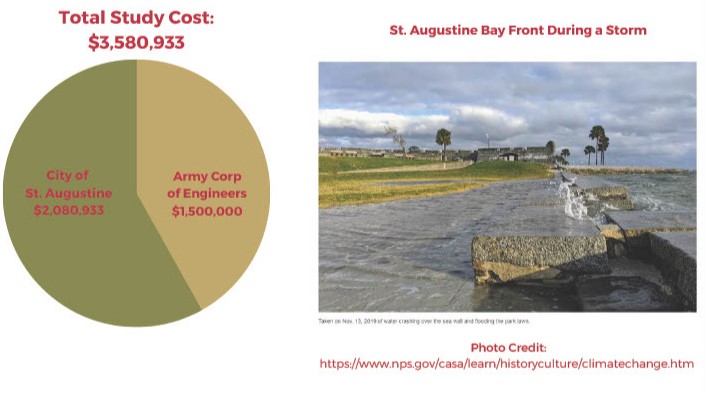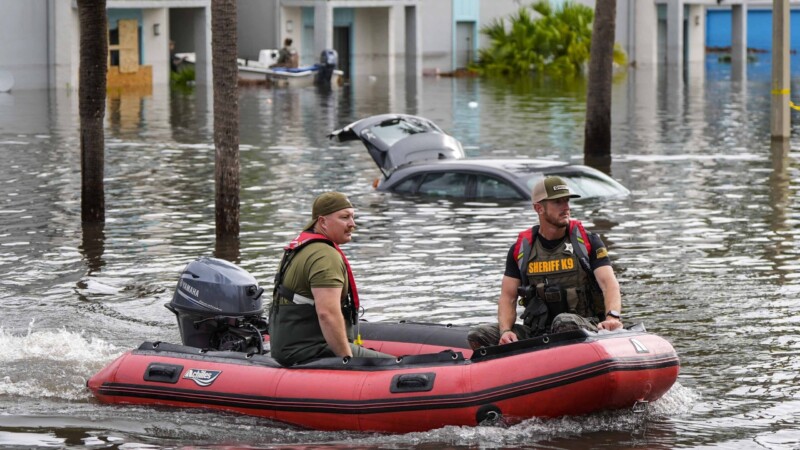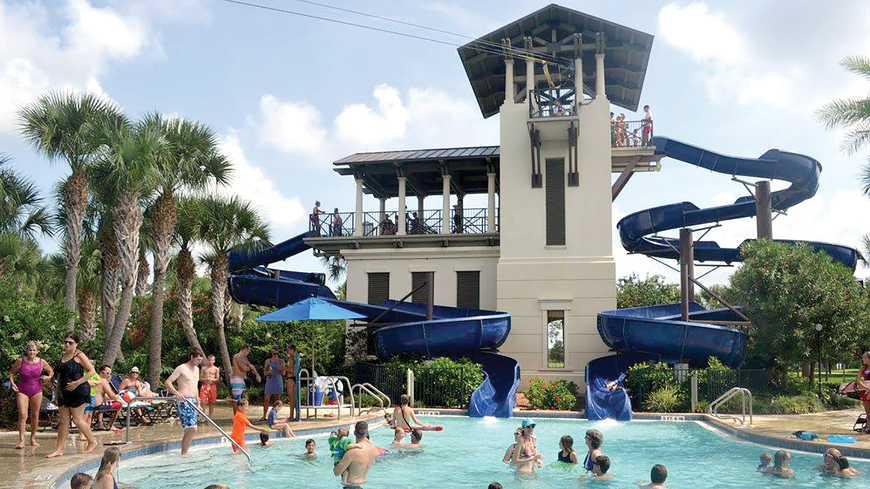When a tropical storm flows into Northeast Florida, higher tides push the Matanzas River into the roads, homes and businesses of historic St. Augustine.
The result is costly damage to centuries-old homes and tourist attractions, plus infrastructure that all must be dried out and repaired, only to flood again in the next big storm or even high tide due to recent water level rise.
Now city officials have approved a three-year study agreement with the U.S. Army Corps of Engineers to find solutions to coastal storm risks, investigating everything from walls to stave off invading waves to relocation of vulnerable structures.
St. Augustine Mayor Nancy Sikes-Kline on Monday signed the St. Augustine/Florida Back Bay Coastal Storm Risk Management Feasibility Study, joined by the corps’ Jacksonville District commander, James Booth. The city and corps each share the $3 million study cost.
For St. Augustine’s chief resilience officer, Jessica Beach, this study is a “multifaceted approach” into coastal storm risk.
“We are basically doing a deep dive into all of the flooding that’s been happening, a lot of it focusing on the coastal aspects of it, whether that’s hurricane beach erosion, storm damage or things of that nature,” Beach said. “We are looking over essentially the next 50 years and what are our options to reduce and mitigate those risks. We have a lot at risk with our cultural and historical resources, and we are trying our best to protect those.”
A history of flooding
Studies have long shown that Downtown St. Augustine is vulnerable to flooding. A 2017 study, drafted through a pilot partnership between the Florida Department of Economic Opportunity and the National Oceanic and Atmospheric Administration, found that a rather moderate sea level rise would affect 20% to 50% of the historic district by the 2040s at the earliest, or 2100 at the latest.
When Hurricane Dorian skirted the east coast of Florida in 2019, the area around the South Davis Shores neighborhood had 32 homes with some type of flooding damage. Then in late September, waves driven by Tropical Storm Ian breached Downtown St. Augustine’s sea wall and rushed into the historic city, flooding State Road A1A near the Bridge of Lions as it pushed inland toward North Ponce De Leon Boulevard.

The reason for this repeated flooding is St. Augustine’s low-lying layout, and not just on the bayfront, said Beach, who took on her job in 2017.
“We actually have many neighborhoods and residential areas that also flood just as substantially as the Downtown area,” she said. “A lot of it is looking at elevations where that water can find its way into, whether it is through storm drains or just overtopping low existing ground elevations.”
That flooding can even happen without a storm, as tidal or “sunny day” flooding occurs when extremely high tides force the ocean into low-lying areas. During those high tides, ocean or river water can force its way up through drainage pipes and into the streets. Add rain, and stormwater can’t drain until the tide falls, so it becomes trapped in the streets and causes even worse flood conditions.
“We have seen an increase in that just in the five years I have been here with the city,” Beach said.
What the study could find
The study will investigate coastal storm effect within the city limits of St. Augustine.
The project team is made up of planners, engineers, biologists, geologists, hydrologists, surveyors, archaeologists, economists, real estate specialists and others. The city is using American Rescue Plan Act funds for its share of the cost. Beach serves as the city’s project manager, coordinating all aspects of the project.
Each team member is responsible for identifying water resources problems and working to find solutions to them within their area of expertise. The team will evaluate ways to reduce coastal storm risk, and explore economically viable and environmentally sound solutions to protect residential, commercial and historic/culturally significant resources. It also will strive to reduce risk from future storms and the effects of sea level change.
The feasibility study will use a six-step planning process (shown below) that seeks alternatives to reduce economic damages from storms over a 50-year period, consistent with environmental statutes. In addition to economic and environmental conditions, regional economic development and social effects will be addressed during the planning.

St. Augustine officials have already begun installing tide check valves to limit “sunny day” flooding. These valves allow stormwater to drain out of drainage systems under low tide conditions but prevent ocean water from backing up into stormwater pipes during high tides.
Other options include moving some structures away from potential flooding or raising them above possible water levels. New levees or flood walls to ward off flood waters are possible, as are changes to shorelines with rocks or vegetation to diffuse floodwaters, as well as oyster beds of coral reefs. As for ocean-borne flooding, adding to sand dunes or building breakwaters is a possibility.
The project schedule starts with data collection and analysis through the end of this year, as well as community outreach already begun with its study website that can accept resident questions or comments, according to Beach.
“That’s actually a really big part of this study,” she said. “This is done in a very open and transparent process, and that is critical is the public engagement. So we will be scheduling a number of workshops, neighborhood and town hall meetings — there will be a variety of ways for the public to be involved.”

Continuing into 2024, development of solutions will lead to a draft report before a final version is sent for review in Washington in July 2025, city officials said. And while the corps is known for its ability to design and build major infrastructure, Beach said the team will look any option for flood control.
Literally, “everything is on the table,” she said.
“It’s going to look at everything in the toolbox to see what can realistically help the city in the long run against coastal storm risk,” she said. “There are a lot of cultural and historical resources at play that we have to take a very close look at and careful consideration of if we have an infrastructure project, what impact would that be. And we look at the environmental pieces of that too.”
Congress has to approve the final proposals, and the city can then seek federal funding that could be a more than 50% match with city funds for projects.
In Summer Haven
Similar flooding issues have beset St. Johns County’s Summer Haven community on State Road A1A South near Marineland. Recent tropical storms have caused two major breaches in the vulnerable land between the ocean and the Matanzas River, putting some of the community’s estimated 300 homes at risk of being washed away.
In November, county commissioners asked staff to explore options to partner with state and federal governments to purchase the affected homes and allow the beach to recover to its natural state. And St. Johns County is working with INTERA-GEC, an environmental consulting firm, to conduct a feasibility study to help develop potential long-term solutions in the Summer Haven area. So county officials are asking all residents to submit questions, comments or concerns regarding that ongoing study to the online Share Point created by INTERA-GEC. The deadline to submit is Jan. 21.
INTERA-GEC will evaluate potential solutions, from sea walls to dune restoration and geo-tube dunes, to abandoning shoreline development along Summer Haven. Each of the potential solutions will be assessed for public benefits, the extent of property protection, constructability and cost.
9(MDEwNzczMDA2MDEzNTg3ODA1MTAzZjYxNg004))






